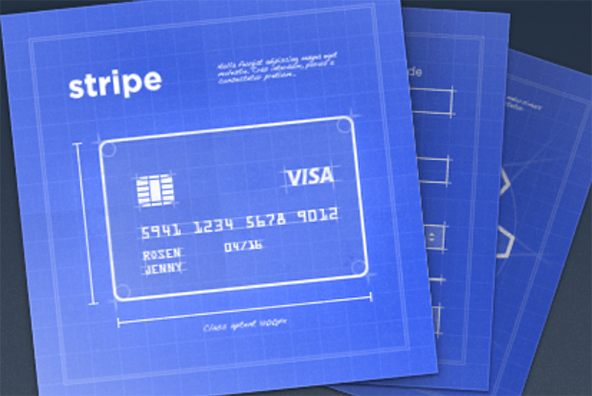Striping up Credit Card Acceptance

I hate to beat up on payments-related start-ups, I really do. But way too often they just ask for it by promoting themselves in ways that are patently deceptive. It’s perfectly alright to speak disparagingly about an industry, which, by wide consensus, is badly in need of reform and to tell people how you are the bearer of long-awaited change. What’s not alright is to then do things precisely the way they are being done by the very old guys you are vying to replace.
On the bright side, we have Jack Dorsey who a couple of years ago said that his Square would make it possible, for the first time ever, for everyone to accept credit cards for payment through his or her phone. And he delivered just that. But everyone else I can think of who’s promised a payments revolution in one form or other in the past few years has turned out, on closer inspection, to be offering simply more of what we already have. My latest entry into this already long list belongs to Patrick Collison, the 24-year-old founder of Stripe — a payments service provider for web-based businesses. Collison counts The Wall Street Journal’s Matthew Lynley among his admirers and it’s through Lynley’s glowing piece that I learned about Stripe. So let’s see what we can make of the start-up.
What Is Stripe?
The start-up’s website tells us that “Stripe makes it easy to start accepting credit cards on the web today” and that it provides “full-stack payments”. If you, like me, are not quite sure exactly what that last phrase means, Stripe elaborates:
You don’t need a merchant account or gateway. Stripe handles everything, including storing cards, subscriptions, and direct payouts to your bank account.
Stripe.js lets you build your own payment forms while still avoiding PCI requirements.
Let’s assume that the technical part is as easily handled, as the start-up tells us (though, in the payments industry, if you do take the website integration part for granted, you are almost certainly setting yourself up for trouble). So you set-up a Stripe account using your email address and “can get started in minutes”, we are told. Presumably that means “start accepting credit card payments in minutes”. That is also how Lynley reads it:
When new users sign up for a website or app, they can immediately begin getting paid for any good or service they sell to other consumers.
Well, it all sounds great until you decide to take a look at the start-up’s long Terms of Service. Once you do that, things become much less clear and straightforward. Let me explain.
Stripes and Twists
Stripe tells you that you don’t need a merchant account — the generic industry term for the type of service, which allows businesses (whether incorporated or sole proprietors) to accept cards for payment. And yet, if you wanted to use the start-up’s service, you would have to go precisely through the type of process you would have gone through if you had applied for a merchant account. To begin with:
You may choose to register as an individual (sole proprietor) or as a company or business. If you register as a company or business, you must also provide information about an owner or principal of the business and you must be authorized to act on behalf of the business and have the authority to bind the business to this Agreement.
Then the following part may have been taken straight out of any traditional processor’s merchant agreement:
To verify your identity, we will require additional information including your business EIN or Tax ID, social security number, and date of birth. We may also ask for additional information to help verify your identity and assess your business risk including business invoices, a driver’s license or other government issued identification, or a business license. We may ask you for financial statements. We may request for your permission to do a physical inspection at your place of business and to examine books and records that pertain to your compliance with this Agreement. Your failure to comply with any of these requests within five (5) days may result in suspension or termination of your Stripe Service Account. You authorize us to retrieve additional information about you from third parties and other identification services. Stripe may use your information to apply for card merchant acquiring accounts on your behalf with certain Networks (such as American Express).
And, just as would be the case if you were applying for a regular merchant account, approval is not guaranteed:
After we have collected and verified all your information, Stripe will review your account and determine if you are eligible to use the Service. Stripe may also share your information with our payment processors (such as Wells Fargo), each of which may also make a determination regarding your eligibility. We will notify you once your account has been either approved or deemed ineligible for use of the Service.
So how is Stripe different from traditional payment processors?
The Takeaway
In his interview with Lynley, Collison talks about the difficulties many web-based businesses have to overcome, before they can start accepting payments. And I can readily confirm that there is a number of industries that are black-listed by the payment networks. However, Stripe itself would not have been able to process payments for the very company — Airbnb — to which Collison refers as he attempts to convince us how badly Stripe is needed. Why? Because Stripe’s Terms of Service puts travel agencies in the list of prohibited businesses. And yes, that is exactly how the underwriter would classify Airbnb. So, I ask you, where is the much-vaunted Stripe advantage?
The bottom line is that the type of service offered by Stripe is precisely what Collison says his company has set out to replace: a merchant account, with all of its limitations and disadvantages. Moreover, the start-up can only provide a garden-variety, low-risk type of merchant account, which places it squarely into a notoriously crowded and competitive market. Perhaps Stripe’s technology would give it an edge, but would that edge be sharp enough to justify a $38 million outside investment? Let’s just say that Stripe will not get anywhere close to becoming the Square for e-commerce businesses.
Image credit: Stripe.com.



a good mobile phone credit card processor is GlobalPay, they offer great rates for processing.